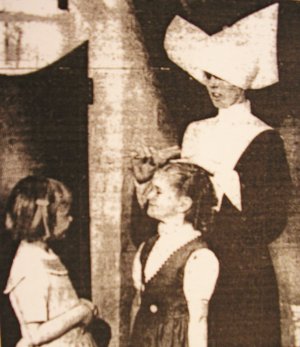
Good-By to Oliver Twist

Good-By to Oliver Twist
 (picture
right: Sister Yvonne Helps Marina and Linda Prepare for School.
(picture
right: Sister Yvonne Helps Marina and Linda Prepare for School.
Good-by to Oliver Twist
by Joan Heil
How do you turn a cold 51-year-old orphanage building into a cheerful home for 112 girls?
It's not easy, according to Sister Mary Thomas, new administrator of Mount St. Joseph's Home for Girls, but these days the huge brick edifice on a hill in the Bayview district is a far cry from the Oliver Twist version of orphanage life.
Small Units.
The regimented institutional concept for orphanages went out the window years ago, according to Sister Mary Thomas, and although St. Joseph's physical plant doesn't lend itself easily to "cottage-type" life, the building has been turned into a series of small, cheerful units.
Seven living areas for different age groups (the girls range from 5 to 18) have been set up inside the building.
In the sunny doll-strewn dormitory for the Pixies (the youngest group of girls), partial partitions break up the large pink and white room where the eleven 5-, 6-, and 7-year-olds, a nun housemother and lay assistant sleep.
Nearby are the Pixie Parlor (a charmingly decorated bathroom and wash-up area), a little dining room and a toy-filled playroom.
Similar separate accomodations are located elsewhere for the rest of the girls: Blue Birds (third and fourth graders), Debs (seventh and eighth grades), Teens (ninth grade), Junior Misses (10th and 11th) and Seniors (11th and 12th).
Broken Homes.
Actually only a few of the girls are orphans. Most of them come from broken or disturbed homes. And most of these are in the adolescent age group.
"We find that adolescents usually adjust better to group living than to a foster home," Sister Mary Thomas reported. "Most of them find it extremely difficult to accept a new set of parents."
The girls attend 16 different Catholic schools in San Francisco, "because we think it is good to break up such a large group," explained the administrator.
"The friendly school competition is healthy, and the girls begin to think of themselves as members of the community."
This community contact extends to attending school dances and parties, going skating at Sutro's, and, for the older girls, riding the Muni buses to class.
No Uniform.
There is no "St. Joseph's Home uniform" to mark the children.
During class hours the dresses of the various schools are worn, and later the girls change into clothing purchased out of their monthly allowances.
A United Crusade agency, the home (run by the Daughters of Charity) is also supported by private donations and help from welfare agencies that refer the girls.
The public will have a chance to see the home in action on Sunday, April 1 when an open house is scheduled.
Helping out in the program will be members of the lay advisory board
(representing business and professional people and homemakers), who assist
in fund-raising and business counseling for St. Joseph's.